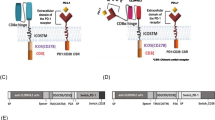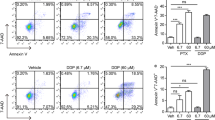Abstract
Objective
To investigate the antitumor effect of tumor necrosis factor-related apoptosis-inducing ligand (TRAIL) gene transfection mediated by adenovirus into human pancreatic carcinoma cell line Panc-1, and the mechanisms involved in this effect.
Methods
TRAIL gene was transfected into pancreatic cancer cell line Panc-1 by an adenovirus vector (Ad-TRAIL). Level of TRAIL mRNA expression was determined using RT-PCR, and TRAIL protein synthesis was evaluated with Western blot. Cell-growth activities were determined by MTT assay. The bystander effect was observed by co-culturing the Panc-1 cells with the transfected TRAIL gene at different ratios. Apoptosis in pancreatic cancer cells was detected by flow cytometry. Procaspase-8 and procaspase-3 were determined by Western blot.
Results
The stable overexpression of TRAIL was detected in Panc-1 cells transfected by Ad-TRAIL. Ad-TRAIL significantly inhibited of cell viability of Panc-1 cells. Furthermore, co-culture of cancer cells transfected with TRAIL with that nontransfected resulted in the cell death of both cells by bystander effect. Moreover, the percentage of apoptotic cells was significantly higher in the Ad-TRAIL-treatment group compared to the control groups (P < 0.01). And there was a diminished amount of procaspase-8 and procaspase-3 after infection with Ad-TRAIL.
Conclusion
The overexpression of TRAIL gene in Panc-1 cells by Ad-TRAIL exerts its antitumor effects, and the mechanisms involved in this effect may be proapoptosis and bystander effect.
Similar content being viewed by others
References
Walczak H, Miller RE, Ariail K, et al. Tumoricidal activity of tumor necrosis factor-related apoptosis-inducing ligand in vivo. Nat Med, 1999, 5: 157–163.
Chen L, Liu Q, Qin R, et al. Amplification and functional characterization of MUC1 promoter and gene-virotherapy via a targeting adenoviral vector expressing hSSTR2 gene in MUC1-positive Panc-1 pancreatic cancer cells in vitro. Int J Mol Med, 2005, 15: 617–626.
Chen LM, Le HY, Qin RY, et al. Reversal of the phenotype by K-rasval12 silencing mediated by adenovirus-delivered siRNA in human pancreatic cancer cell line Panc-1. World J Gastroenterol, 2005, 11: 831–838.
Ashkenazi A, Pai RC, Fong S, et al. Safety and antitumor activity of recombinant soluble Apo2 ligand. J Clin Invest, 1999, 104: 155–162.
Ibrahim SM, Ringel J, Schmidt C, et al. Pancreatic adenocarcinoma cell lines show variable susceptibility to TRAIL-mediated cell death. Pancreas, 2001, 23: 72–79.
Verma IM, Somia N. Gene therapy-promises, problems and prospects. Nature, 1997, 389: 239–242.
Walczak H, Bouchon A, Stahl H, et al. Tumor necrosis factor-related apoptosis-inducing ligand retains its apoptosis-inducing capacity on Bcl-2-or Bcl-xL-overexpressing chemotherapy-resistant tumor cells. Cancer Res, 2000, 60: 3051–3057.
Eggert A, Grotzer MA, Zuzak TJ, et al. Resistance to tumor necrosis factor-related apoptosis-inducing ligand (TRAIL)-induced apoptosis in neuroblastoma cells correlates with a loss of caspase-8 expression. Cancer Res, 2001, 61: 1314–1319.
Satoh K, Kaneko K, Hirota M, et al. Tumor necrosis factor-related apoptosis-inducing ligand and its receptor expression and the pathway of apoptosis in human pancreatic cancer. Pancreas, 2001, 23: 251–258.
Daniel PT, Wieder T, Sturm I, et al. The kiss of death: promises and failures of death receptors and ligands in cancer therapy. Leukemia, 2001, 15: 1022–1032.
Mesnil M, Yamasaki H. Bystander effect in herpes simplex virus-thymidine kinase/ganciclovir cancer gene therapy: role of gap-junctional intercellular communication. Cancer Res, 2000, 60: 3989–3999.
Shao R, Xia W, Hung MC. Inhibition of angiogenesis and induction of apoptosis are involved in E1A-mediated bystander effect and tumor suppression. Cancer Res, 2000, 60: 3123–3126.
Bai S, Du L, Liu W, et al. Tentative novel mechanism of the bystander effect in glioma gene therapy with HSV-TK/GCV system. Biochem Biophys Res Commun, 1999, 259: 455–459.
Author information
Authors and Affiliations
Corresponding author
Additional information
Supported by a grant from the National Natural Science Foundation of China (No. 30471693).
Rights and permissions
About this article
Cite this article
Tian, R., Qin, R., Du, Z. et al. Recombinant adenoviral vector expressing the tumor necrosis factor-related apoptosis-inducing ligand gene suppresses human pancreatic cancer growth. Chinese German J Clin Oncol 6, 464–468 (2007). https://doi.org/10.1007/s10330-007-0013-8
Received:
Revised:
Accepted:
Issue Date:
DOI: https://doi.org/10.1007/s10330-007-0013-8




